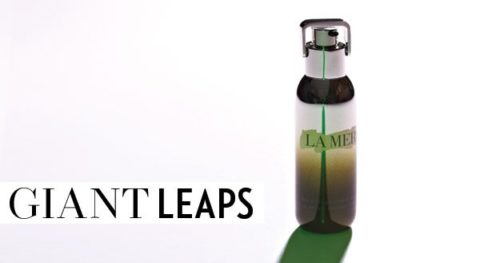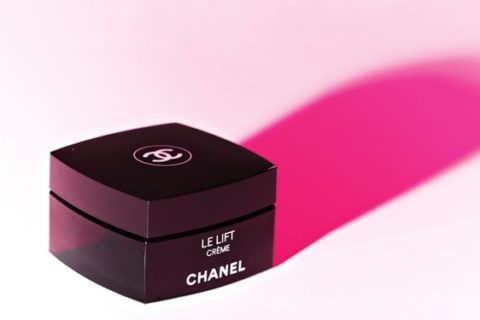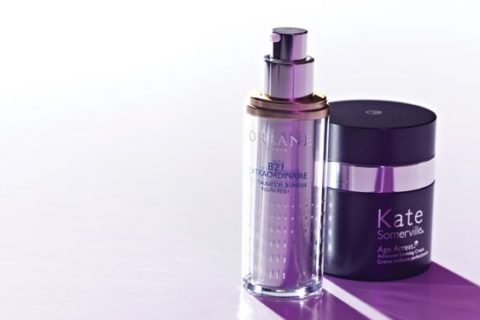3D printing, epigenetics and telomeres: 3 futuristic areas inspiring high-performance anti-aging skincare


Flexible glass is coming soon to curved cellphone displays. Suspension furniture held together by tension is eliminating the need for glue. And 3D printing is being used everywhere from the medical world—to recreate miniature human kidneys and livers in hopes of eventually using them in transplants—to the runway, where Dutch designer Iris van Herpen incorporated it into her couture collection last July.
The ways in which we’re now able to change a form’s shape are multiplying by the minute. Referring to the trend as “shape creation,” Loretta Miraglia, corporate senior vice-president of global brand product development and innovation at La Mer, says she believes it’s the third industrial revolution. “It’s going to influence almost every industry, including ours.” And it’s what inspired her to bring the concept to anti-aging skincare with The Lifting Contour Serum ($330, at Holt Renfrew).
For Miraglia and her team, that meant creating a product that could raise and reshape the face. “I started thinking about the architecture of the skin,” she says. “How can we build a structure, a scaffolding if you will, or the elasticity of a trampoline?” The first step was increasing skin’s density by arming the fibroblast cells with energy to spin more collagen and elastin. To achieve that, they amped up the quantity of “miracle broth,” the fermented sea kelp mixture in every La Mer product. “It brings a direct line of energy into the fibroblasts,” claims Miraglia. “This is the food they need to create collagen and elastin.”
But the formula needed additional support. Aging skin cells generate enzymes called collagenase and elastase. “They’re the ones that snip snip snip snip the collagen fibres from the fibroblasts, so then they’re just floating around doing nothing at all,” says Miraglia. In other words, they sever the bungee cords that keep our faces taut. The team came upon perennial brown algae, which is found in the shallow coastal waters of the North Atlantic and is already being used in the medical and food industries. It delivers oxygen that fuels the fibroblasts, giving them additional energy to produce more fibres and stay securely attached. “It’s helping anchor the fibroblasts to the dermis, and that’s critical,” Miraglia says. Rounding out the formula are marine peptides and copper-rich blue algae, all of which is fermented for 72 hours to make it biocompatible.
The final concoction, which Miraglia jokingly calls “liquid Spanx,” aims to make skin as firm and resilient as pliable glass. “It’s the idea of creating a flexible structure with something that’s bringing the elasticity back and allowing the edge to lift,” she says. Ideally, the skin would also become stronger, in the same way a luxurious fabric’s density is enhanced. “It’s like it has a warp and a weft,” says Miraglia. “The higher the collagen and elastin thread count, the tighter the knit. And everybody wants to sleep on a 1,500-thread-count sheet.” That we do.
—Lesa Hannah

“It’s just good genes” is a cop-out. Using that to explain away a luminous 60-something’s barely lined eyes or youthful glow (hey, Susan Sarandon) is to ignore both the power of well-placed cream blush and the growing field of epigenetics. The study of what affects the way our genes express, it has led to a focus on the roles played by stress, nutrition, exercise, sleep—and now skincare creams ambitiously designed to act further and further upstream on the skin’s aging process. We’re way beyond basic hydration. “Moisturization is very important, but that’s not enough when we speak about the process of aging,” says Marie-Hélène Lair, scientific communica–tion director for Chanel. “I think it’s very smart to act at this level, just after the gene expression.”
Keen to “hijack” the aging process, Chanel has jumped on the research of Dr. Gerry Melino, an Italian biochemist specializing in cellular senescence, or deterioration, to create Le Lift ($160, at department stores). Melino studies the role of chemical “switches,” dubbed miRs, that influence the way our genes create proteins to carry out their instructions in our bodies. Of interest here are the “youth proteins” P63 and Sirtuin 1, so called because they regulate fibroblasts, which are key players in our skin’s thickness, suppleness and resilience.
Applying his expertise to skincare for the first time, Melino has isolated three miRs in particular that lord it over the youth proteins, multiplying over time. The more of these miRs that come to the party, the more the youth proteins decide they’re not welcome and beat a retreat—and you can imagine what happens when the youth proteins leave.
Armed with this knowledge, and research showing that miR activity is affected by external factors such as life-style and emotions, Chanel’s formulators went looking for an active ingredient that would intervene and keep them in check. Aligning itself with another scientist—French biotechnology and agronomy expert Professor Frédéric Bourgaud, who invented plant “milking” technology—Chanel isolated an extract drawn from the roots of the edulis plant, native to Central America. Cultivated in greenhouses, the plants hover a metre above the ground, their trailing roots hanging down in mid-air. They’re misted every three minutes with a nourishing concoction and milked for their super-concentrated elixir—a process that can be repeated six times per year. It’s a futuristic and sustainable method: no pesticides are used, no plots of land compromised.
The resulting molecule is the “hero” ingredient in Le Lift, which comes in three incrementally richer textures. All give an immediate sense of plumped dewiness to tide over impatient anti-agers until the molecule has time to make its way back to the beginning of everything, to try to slow down the clock where it starts ticking. But then we have all the time in the world for
that.
—Rani Sheen

Sometimes, 40 really is the new 30. And the tipoff isn’t work done with a syringe, but the state of your telomeres. Are they long—a sign of youth and vitality? Or short—an indicator of premature aging? Telomeres are the protective bits of DNA that sit at the ends of our chromosomes like caps on shoelaces, safeguarding our genetic information and providing insight into how fast we’re aging. It’s no wonder telomere technology has segued into skincare.
“Telomeres are the new thing, just like stem cells were,” says Manhattan dermatologist Dr. Paul Jarrod Frank. “But it’s premature to say they’re the key to health, beauty and longevity. Anecdotally, we know that if we smoke and drink more, our telomeres can shorten, but in terms of skincare there’s so much we don’t know.” That hasn’t stopped savvy brands from develop–ing what they call telomere-protective compounds. To make the leap from chromosomes to creams, it helps to dip into the science.
When a cell divides, telomeres shorten. If they get too short, the cell stops dividing and deteriorates. In the case of your face, this impaired cellular function may translate to slowed cell repair and renewal and waning collagen and elastin. Kate Somerville’s answer is Telo-5, found in Age Arrest Anti-Wrinkle Cream ($105, sephora.com). The L.A. facialist claims the ingredient works with the skin’s repair mechanism, improving elasticity, discolouration and collagen production. “In in-vitro experiments, the technology is shown to protect the telomeric ends, helping to minimize deterioration. I think of it
like an insurance policy against aging,” she says. Orlane, meanwhile, has created Telo-protectyl, found in B21 Extra–ordinaire Youth Reset serum ($225, at Shoppers Drug Mart). The free-radical-fighting lipid is designed to maintain telomere length by limiting oxidative stress. But the idea that a topical product can affect our telomeres is a sticking point for Frank. “If these creams made changes to the DNA of the skin, they’d be classified as drugs and regulated by the FDA.” One thing that has been proven to lengthen telomeres is the enzyme telomerase. Oral supplements have been shown to increase the body’s production of it, but the jury is out on whether it can be stimulated in the skin by a cream—and whether that in turn would deliver skin that looks decades younger. “I think there’s a future in telomeres and telomerase for skincare,” says Frank, “but right now it’s still very sci-fi.”
—Wendy Schmid







